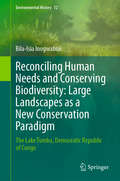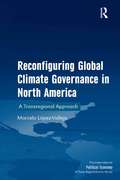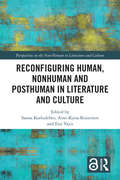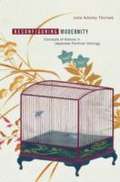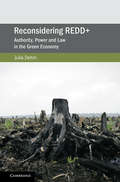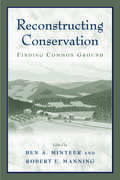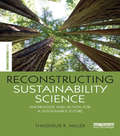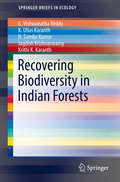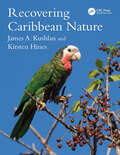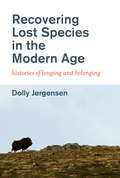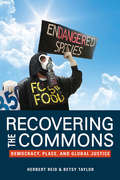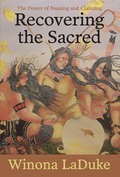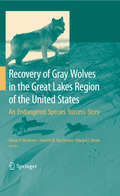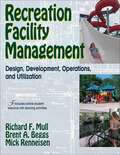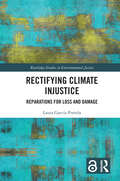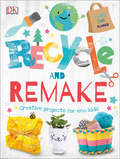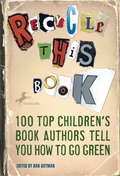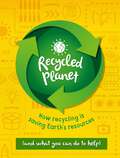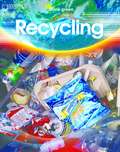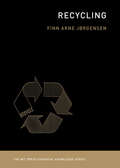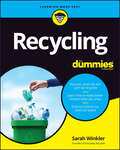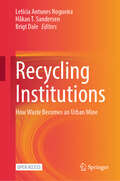- Table View
- List View
Reconciling Human Needs and Conserving Biodiversity: The Lake Tumba, Democratic Republic of Congo (Environmental History #12)
by Bila-Isia InogwabiniProtected areas have often been defined as the backbones of biodiversity conservation. Protected areas have often been defined as the backbones of biodiversity conservation. However, legitimate demands formulated by countries for their economic development, growing human populations, forest fragmentations, and needs of local communities for sustainable livelihoods are also pressing demands on protected areas, stringently pressuring conservation community to identify means to reconcile long term biodiversity conservation and communities’ livelihoods. Hence, integrating conservation activities within the global framework of economic development of countries with high biodiversity had become part of conservation paradigms. Integrated development as a route to conservation, strict protected areas, community managed areas, etc. have been tried but resulted in debatable outcomes in many ways. The lukewarm nature of these results brought ‘landscape approach’ at the front of biodiversity conservation in Central Africa. Since the late 1990s the landscape approach uses large areas with different functional attributes and shifts foundational biodiversity conservation paradigms. Changes are brought to the role traditionally attributed to local communities, aligning sustainable development with conservation and stretching conservation beyond the confines of traditional protected areas. These three shifts need a holistic approach to respond to different conservation questions. There are only a few instances where the landscape experience has been scientifically documented and lessons learnt drawn into a corpus of knowledge to guide future conservation initiatives across Central Africa. To subjugate one biodiversity conservation landscape as one case study emerged as a matter of urgency to present the potential knowledge acquired throughout the landscape experiment, including leadership and management, processes tried, results (at least partially) achieved, and why such and such other process or management arrangement were been chosen among many other alternatives, etc. The challenges of the implementation of the conservation landscape approach needed also to be documented. This book responds to the majority of these questions; drawing its content from the firsthand field knowledge, it discusses these shifts and documents what has been tried, how successful (unsuccessful) it was, and what lessons learnt from these trials. Theoretical questions such as threat index, and ecological services, etc. are also discussed and gaps in knowledge are identified.
Reconciling Indigenous Peoples’ Individual and Collective Rights: Participation, Prior Consultation and Self-Determination in Latin America (Indigenous Peoples and the Law)
by Jessika EichlerThis book critically assesses categorical divisions between indigenous individual and collective rights regimes embedded in the foundations of international human rights law. Both conceptual ambiguities and practice-related difficulties arising in vernacularisation processes point to the need of deeper reflection. Internal power struggles, vulnerabilities and intra-group inequalities go unnoticed in that context, leaving persisting forms of neo-colonialism, neo-liberalism and patriarchalism largely untouched. This is to the detriment of groups within indigenous communities such as women, the elderly or young people, alongside intergenerational rights representing considerable intersectional claims and agendas. Integrating legal theoretical, political, socio-legal and anthropological perspectives, this book disentangles indigenous rights frameworks in the particular case of peremptory norms whenever these reflect both individual and collective rights dimensions. Further-reaching conclusions are drawn for groups ‘in between’, different formations of minority groups demanding rights on their own terms. Particular absolute norms provide insights into such interplay transcending individual and collective frameworks. As one of the founding constitutive elements of indigenous collective frameworks, indigenous peoples’ right to prior consultation exemplifies what we could describe as exerting a cumulative, spill-over and transcending effect. Related debates concerning participation and self-determination thereby gain salience in a complex web of players and interests at stake. Self-determination thereby assumes yet another dimension, namely as an umbrella tool of resistance enabling indigenous cosmovisions to materialise in the light of persisting patterns of epistemological oppression. Using a theoretical approach to close the supposed gap between indigenous rights frameworks informed by empirical insights from Bolivia, the Andes and Latin America, the book sheds light on developments in the African and European human rights systems.
Reconfiguring Global Climate Governance in North America: A Transregional Approach (The International Political Economy of New Regionalisms Series)
by Marcela Lopez-VallejoGlobal climate governance has presented problems that have led to failures, yet it has also opened the door to new transregional governance schemes, especially in North America. This book introduces an environmental dimension into the concept of governance. Almost fifteen years after the climate global governance concept emerged, results worldwide have not been as favorable as expected. This book details previous discussions about the concept of global climate governance and its limits. It highlights how the Kyoto Protocol has a limited design taking into account a national approach to global, regional, and transnational problems, had no obligatory mechanisms for implementation and explains the emergence of new polluters not committed under it such as China and India. Furthermore this book explores other levels of authority such as regional institutions - the North American agreement on trade (NAFTA) and on environment (NAAEC), as well as the regional energy working group (NAEWG). The author puts forward a theoretical proposal for re-territorialization and coordination of policies for climate change into new forms of articulating interests in what she terms transnational green economic regions (TGERs) and tests this on two case studies - the Regional Greenhouse Gas Initiative (RGGI) and the Western Climate Initiative (WCI). This study presents the challenges and opportunities of a transregional approach in North America.
Reconfiguring Human, Nonhuman and Posthuman in Literature and Culture (Perspectives on the Non-Human in Literature and Culture)
by Sanna Karkulehto Aino-Kaisa Koistinen Essi VarisThe time has come for human cultures to seriously think, to severely conceptualize, and to earnestly fabulate about all the nonhuman critters we share our world with, and to consider how to strive for more ethical cohabitation. Reconfiguring Human, Nonhuman and Posthuman in Literature and Culture tackles this severe matter within the framework of literary and cultural studies. The emphasis of the inquiry is on the various ways actual and fictional nonhumans are reconfigured in contemporary culture – although, as long as the domain of nonhumanity is carved in the negative space of humanity, addressing these issues will inevitably clamor for the reconfiguration of the human as well.
Reconfiguring Modernity: Concepts of Nature in Japanese Political Ideology
by Julia Adeney ThomasA study of changing Japanese understandings of "nature" from the mid-19th century to the early 20th century.
Reconsidering REDD+: Authority, Power and Law in the Green Economy (Cambridge Studies on Environment, Energy and Natural Resources Governance)
by Julia DehmIn Reconsidering REDD+: Authority, Power and Law in the Green Economy, Julia Dehm provides a critical analysis of how the Reducing Emissions from Deforestation and Forest Degradation (REDD+) scheme operates to reorganise social relations and to establish new forms of global authority over forests in the Global South, in ways that benefit the interests of some actors while further marginalising others. In accessible prose that draws on interdisciplinary insights, Dehm demonstrates how, through the creation of new legal relations, including property rights and contractual obligations, new forms of transnational authority over forested areas in the Global South are being constituted. This important work should be read by anyone interested in a critical analysis of international climate law and policy that offers insights into questions of political economy, power, and unequal authority.
Reconstructing Conservation: Finding Common Ground
by Ben A. Minteer Robert E. ManningIn the 1990s, influenced by the deconstructionist movement in literary theory and trends toward revisionist history, a cadre of academics and historians led by William Cronon began raising provocative questions about ideas of wilderness and the commitments and strategies of the contemporary environmental movement. While these critiques challenged some cherished and widely held beliefs -- and raised the hackles of many in the environmental community -- they also stimulated an important and potentially transformative debate about the conceptual foundations of environmentalism.Reconstructing Conservation makes a vital contribution to that debate, bringing together 23 leading scholars and practitioners -- including J. Baird Callicott, Susan Flader, Richard Judd, Curt Meine, Bryan Norton, and Paul B. Thompson -- to examine the classical conservation tradition and its value to contemporary environmentalism. Focusing not just on the tensions that have marked the deconstructivist debate over wilderness and environmentalism, the book represents a larger and ultimately more constructive and hopeful discussion over the proper course of future conservation scholarship and action.Essays provide a fresh look at conservation icons such as George Perkins Marsh and Aldo Leopold, as well as the contributions of lesser-known figures including Lewis Mumford, Benton MacKaye, and Scott Nearing. Represented are a wealth of diverse perspectives, addressing such topics as wilderness and protected areas, cultural landscapes, rural/agrarian landscapes, urban/built environments, and multiple points on the geographic map. Contributors offer enthusiastic endorsements of pluralism in conservation values and goals along with cautionary tales about the dangers of fragmentation and atomism. The final chapter brings together the major insights, arguments, and proposals contained in the individual contributions, synthesizing them into a dozen broad-ranging principles designed to guide the study and practice of conservation.Reconstructing Conservation assesses the meaning and relevance of our conservation inheritance in the 21st century, and represents a conceptually integrated vision for reconsidering conservation thought and practice to meet the needs and circumstances of a new, post-deconstructivist era.
Reconstructing Sustainability Science: Knowledge and action for a sustainable future (The Earthscan Science in Society Series)
by Thaddeus R. MillerThe growing urgency, complexity and "wickedness" of sustainability problems—from climate change and biodiversity loss to ecosystem degradation and persistent poverty and inequality—present fundamental challenges to scientific knowledge production and its use. While there is little doubt that science has a crucial role to play in our ability to pursue sustainability goals, critical questions remain as to how to most effectively organize research and connect it to actions that advance social and natural wellbeing. Drawing on interviews with leading sustainability scientists, this book examines how researchers in the emerging, interdisciplinary field of sustainability science are attempting to define sustainability, establish research agendas, and link the knowledge they produce to societal action. Pairing these insights with case studies of innovative sustainability research centres, the book reformulates the sustainability science research agenda and its relationship to decision-making and social action. It repositions the field as a "science of design" that aims to enrich public reasoning and deliberation while also working to generate social and technological innovations for a more sustainable future. This timely book gives students, researchers and practitioners a valuable and unique analysis of the emergence of sustainability science, and both the opportunities and barriers faced by scientific efforts to contribute to social action.
Recovering Biodiversity in Indian Forests
by G. Vishwanatha Reddy K. Ullas Karanth N. Samba Kumar Jagdish Krishnaswamy Krithi K. KaranthThis book demonstrates how varying levels of human disturbance manifested through different management regimes influence composition, richness, diversity and abundance of key mammal, bird and plant species, even within ecologically similar habitats. Based on our results, we show the critical importance of the 'wildlife preservation' approach for effective biodiversity conservation. The study also provides examples of a practical application of rigorous methods of quantitative sampling of different plant and animal taxa as well as human influences, thus serving as a useful manual for protected area managers. Protectedareas of various kinds have been established in India with the goal ofarresting decline in, and to provide for, recovery of biodiversity andecosystem services. A model that targets 'wildlife preservation' under stateownership is practiced across the country. However, forests in India are underintensive human pressure and varying levels of protection; therefore, protectedareas may also experience open-access resource use, a model that is beingaggressively advocated as a viable alternative to 'preservationism'. We haveevaluated the conservation efficacy of alternative forest management models byquantifying levels of biodiversity under varied levels of access, resourceextraction and degree of state-sponsored protection in the Nagarahole forestlandscape of southwestern India.
Recovering Caribbean Nature
by James A. Kushlan Kirsten HinesThe Caribbean is a global biodiversity hotspot; half its resident bird species are found nowhere else, yet, a quarter are threatened with extinction. Nearly all its native amphibians and reptiles and thousands of plants also are endemic. Yet, less than 1% of the landscape can be considered natural; and apart from reserves, most land is privately owned. Despite the challenges of such habitat fragmentation, the Caribbean’s distinctive fauna and flora can be preserved through planning and managing a connected network of sustainable naturalistic landscapes, reserves, parks, and private gardens. This book uniquely provides both a theoretical background and practical applications to restoring nature within the tropical Caribbean. Packed with beautiful color photographs, it offers unifying principles that can be applied across the tropics and synthesizes information on the Caribbean's environmental uniqueness and globally significant biodiversity. It also provides explicit guidance on establishing sustainable and more naturalistic landscapes from large public lands to private yards and gardens.The book is essential reading for academics and researchers studying the Caribbean environment, resource management professionals, and scientists and.educatos from nongovernmental organizations who provide programs and advocacy for conservation and regional sustainability. Moreover, it highlights the importance of private lands and gardens, where the greatest gains can be made, and so offers a handbook for knowledgeable private landowners and their professional advisors.
Recovering Lost Species in the Modern Age: Histories of Longing and Belonging (History for a Sustainable Future)
by Dolly JorgensenA groundbreaking study of how emotions motivate attempts to counter species loss. This groundbreaking book brings together environmental history and the history of emotions to examine the motivations behind species conservation actions. In Recovering Lost Species in the Modern Age, Dolly Jørgensen uses the environmental histories of reintroduction, rewilding, and resurrection to view the modern conservation paradigm of the recovery of nature as an emotionally charged practice. Jørgensen argues that the recovery of nature—identifying that something is lost and then going out to find it and bring it back—is a nostalgic practice that looks to a historical past and relies on the concept of belonging to justify future-oriented action. The recovery impulse depends on emotional responses to what is lost, particularly a longing for recovery that manifests itself in such emotions as guilt, hope, fear, and grief. Jørgensen explains why emotional frameworks matter deeply—both for how people understand nature theoretically and how they interact with it physically. The identification of what belongs (the lost nature) and our longing (the emotional attachment to it) in the present will affect how environmental restoration practices are carried out in the future. A sustainable future will depend on questioning how and why belonging and longing factor into the choices we make about what to recover.
Recovering the Commons: Democracy, Place, and Global Justice
by Herbert Reid Betsy TaylorThis penetrating work culls key concepts from grassroots activism to hold critical social theory accountable to the needs, ideas, and organizational practices of the global justice movement. The resulting critique of neoliberalism hinges on place-based struggles of groups marginalized by globalization and represents a brave rethinking of politics, economy, culture, and professionalism. Providing new practical and conceptual tools for responding to human and environmental crises in Appalachia and beyond, Recovering the Commons radically revises the framework of critical social thought regarding our stewardship of the civic and ecological commons. Herbert Reid and Betsy Taylor ally social theory, field sciences, and local knowledge in search of healthy connections among body, place, and commons that form a basis for solidarity as well as a vital infrastructure for a reliable, durable world. Drawing particularly on the work of philosophers Maurice Merleau-Ponty, John Dewey, and Hannah Arendt, the authors reconfigure social theory by ridding it of the aspects that reduce place and community to sets of interchangeable components. Instead, they reconcile complementary pairs such as mind/body and society/nature in the reclamation of public space. With its analysis embedded in philosophical and material contexts, this penetrating work culls key concepts from grassroots activism to hold critical social theory accountable to the needs, ideas, and organizational practices of the global justice movement. The resulting critique of neoliberalism hinges on place-based struggles of groups marginalized by globalization and represents a brave rethinking of politics, economy, culture, and professionalism.
Recovering the Sacred: The Power of Naming and Claiming
by Winona LaDuke“Through the voices of ordinary Native Americans . . . LaDuke is able to transform highly complex issues into stories that touch the heart.” —Roxanne Dunbar-Ortiz, author of An Indigenous Peoples’ History of the United StatesThe indigenous imperative to honor nature is undermined by federal laws approving resource extraction through mining and drilling. Formal protections exist for Native American religious expression—but not for the places and natural resources integral to ceremonies. Under what conditions can traditional beliefs be best practiced?From the author of All Our Relations: Native Struggles for Land and Life, Recovering the Sacred features a wealth of native research and hundreds of interviews with indigenous scholars and activists.“Documents the remarkable stories of indigenous communities whose tenacity and resilience has enabled them to reclaim the lands, resources, and life ways after enduring centuries of incalculable loss.” —Wilma Mankiller, author of Every Day is a Good Day
Recovery of Gray Wolves in the Great Lakes Region of the United States: An Endangered Species Success Story
by Adrian P. Wydeven Edward Heske Timothy R. DeelenThe Great Lakes region is unique in that it is the only portion of the lower 48 states where wolves were never extirpated. As the birthplace of some of the first modern concepts of wolf conservation and research, the region is also the first place in the U.S. where "endangered" wolf populations recovered. During this process, much has been learned about wolf biology and ecology, endangered species management, carnivore conservation, landscape ecology, depredation management, and social aspects of wildlife conservation. Recovery of Gray Wolves in the Great Lakes Region of the United States traces wolf recovery in this region and highlights lessons learned by conservationists during the recovery process. Each chapter includes a thorough review of the pertinent literature, in addition to new data and new perspectives and interpretations. The result is both rigorous with respect to science and policy and accessible and interesting for the lay reader. The story of wolf recovery in the Great Lakes region is one of international significance for conservationists.
Recreation Facility Management: Design, Development, Operations And Utilization
by Richard F. Mull Brent A. Beggs Mick RenneisenRecreation facility management is a complex responsibility. Professionals in this field are responsible for various types of facilities—recreation centers, water parks and pools, playgrounds, parks, fitness centers, sport complexes, and resorts—each with its own set of goals and challenges. Recreation Facility Management: Design, Development, Operations, and Utilization provides students and new professionals with a basic understanding of recreation facilities and prepares them to perform the duties required of a recreation facility manager. Part I of Recreation Facility Management offers a detailed look at the foundations of the profession, including the defining characteristics of recreation facility management and descriptions of the duties of a recreation facility manager and the areas within the facilities. Also featured are descriptions of the common indoor and outdoor elements of facilities, including sites, spaces, lighting, surfaces, utilities, landscaping, walkways, and parking areas. The remaining parts of the book detail the practical knowledge and skills as well as tasks and processes required for managing various types of recreation facilities. Readers will find these features: A thorough discussion of the facility design and development process, including needs assessment, planning, reading blueprints, funding, the bid process, and construction Information on managing facility resources, including equipment; financial issues, such as budgeting, taxes, fees and charges, and donations; and human resources, including hiring, training, and evaluating employees A detailed examination of facility utilization, including safety and security, scheduling, maintenance, and emergencies and emergency response A review of parks, playgrounds, aquatic facilities, and ancillary spaces, including parking areas, showers and restrooms, and child care areas Coverage of national industry standards and guidelines for various types of facilities Throughout the book readers will find examples from settings in recreation, leisure, parks, and tourism that will help them apply their knowledge to various types of recreation facilities. Recreation Facility Management also includes access to an online student resource (OSR) that will help students tie the information in the book to practical matters on the job. The OSR contains learning activities, forms from the files of actual facility managers, worksheets, and Web links to help students further explore the ideas found in the book. Recreation Facility Management offers a practical introduction to facility design, management, and maintenance for practicing or future recreation professionals. This resource provides the knowledge and skills necessary for becoming a successful facility manager in any recreation setting.
Recreational Vehicle Cookbook
by Charlotte DawsonIn her RECREATIONAL VEHICLE COOKBOOK Charlotte Dawson has collected some of the favorite recipes of fascinating people she and her husband have met on their travels throughout the United States. While most of the recipes lend themselves beautifully to recreational cooking because of their simplicity they are far from commonplace. Molasses pie, Sabattus stew, swamp cabbage, corn custard, Johnny Johnson's chili concoction and recipes from the Ladies' Auxiliary of the Hatteras Volunteer Fire Department are only a sampling of the many, many unusual recipes you will find between theese covers. Mrs. Dawson has organized her cookbook into regions of America. Represented are New England, the Middle Atlantic States, Southeast, Pacific Northwest and the Southwest. Also included are a host of recipes that are delicious just about everywhere.
Rectifying Climate Injustice: Reparations for Loss and Damage (Routledge Studies in Environmental Justice)
by Laura García-PortelaThis book provides an account of how rectificatory justice for climate change loss and damage can be realized by bridging the worlds of political philosophy, climate science and climate policy together. The book focuses on three fundamental questions: what kinds of climate impacts should count as loss and damage, how climate science can help us identify them and who should bear the burdens of providing reparations for loss and damage.Laura García-Portela argues that loss and damage occur after people’s capabilities have fallen below a threshold of sufficiency due to the negative impacts of climate change, thereby infringing people’s human rights. She argues for a historical responsibility principle for reparations for loss and damage (the Polluter Pays Principle, PPP) grounded in her Continuity Account. According to this account, responsibility for reparations is based on the duty to refrain from emissions-generating activities that would infringe people’s human rights. A new duty to provide reparations arises when human rights are infringed by climate change-inducing activities. Importantly, she examines how the latest developments in attribution science can help in developing a rectificatory account for loss and damage, an approach that has not been considered in depth by climate justice scholars so far.Striving to improve the reader’s understanding of loss and damage as outlined by The United Nations Framework Convention on Climate Change, this book will be of great interest to students and scholars of climate justice, environmental justice, and environmental ethics.
Recycle and Remake: Creative Projects for Eco Kids
by DKKids are on a mission to save the Earth! Recycle and Remake is the hands-on, practical guide they need to get started.This gentle, but empowering book is full of creative making activities, information, and ideas that give young eco-warriors the know-how to really help the environment. With Recycle and Remake, kids will soon be saving trees by making their own seeded recycled paper from junk mail, cleaning up the oceans by turning old shopping bags into kites, friendship bracelets, and colorful woven baskets, and repurposing a cardboard box into a periscope. They'll also learn about sustainable energies by creating a simple solar oven, cutting down on plastic wrap by making a food wrap from scrap cotton and beeswax, and turning an old tee shirt into a reusable tote bag. They can even grow new plants to clean the air in their own upcycled milk bottle planters and using homemade compost.As kids make and create, they will learn kid-friendly facts about the big issues our planet is facing. Each of the activities directly relates to an environmental hot topic, such as plastic pollution, food waste, or deforestation. Budding environmentalists all over the world are feeling inspired to do their part for our amazing planet. This future-friendly book is here to guide them with all the information, ideas, tips, and tools they need to be part of the solution.
Recycle this Book
by Dan GutmanWith essays from renowned children's book authors such as Ann Brashares, Jeanne DuPrau, Caroline B. Cooney, Laurie Halse Anderson, Bruce Coville, Gennifer Choldenko, and over 100 others, each piece is an informative and inspiring call to kids of all ages to understand what's happening to the environment, and to take action in saving our world.Helpful tips and facts are interspersed throughout. This book will be a great classroom tool to teach young readers how they can help to make the Earth a greener place.From the Trade Paperback edition.
Recycled Planet
by Anna ClaybourneRecycled Planet explains to young readers how essential recycling is in today's worldRecycling is part of everyday life today. From food scraps to mobile phones, recycling gives many materials a new lease of life and prevents them from polluting our planet, as well as saving energy.Recycled Planet explores the world of recycling, looking at what we recycle, how it is collected and separated and what happens during the recycling process. It also looks at new forms of recycling, from deposit schemes to repurposing, and assesses some innovations designed to make recycling more global and efficient. Simple activities encourage readers to take part in recycling themselves and to aim to recycle even more!Following on from Plastic Planet and Hot Planet, Recycled Planet will feature the same blend of illustrations and photos and a striking cover, and is written by the award-winning science author Anna Claybourne.Aimed at readers aged 9 plus.
Recycling
by Saddleback Educational Publishing StaffTeach environmental studies and global warming in the inclusive classroom with these unique informational books. summarizes critical information. The index takes students directly to topics of interest.
Recycling (The MIT Press Essential Knowledge Series)
by Finn Arne JorgensenAn overview of recycling as an activity and a process, following different materials through the waste stream.Is there a point to recycling? Is recycling even good for the environment? In this volume in the MIT Press Essential Knowledge series, Finn Arne Jørgensen answers (drumroll, please): it depends. From a technical point of view, recycling is a series of processes—collecting, sorting, processing, manufacturing. Recycling also has a cultural component; at its core, recycling is about transformation and value, turning material waste into something useful—plastic bags into patio furniture, plastic bottles into T-shirts. Jørgensen offers an accessible and engaging overview of recycling as an activity and as a process at the intersection of the material and the ideological. Jørgensen follows a series of materials as they move back and forth between producer and consumer, continually transforming in form and value, in a never-ceasing journey toward becoming waste. He considers organic waste and cultural contamination; the history of recyclable writing surfaces from papyrus to newsprint; discarded clothing as it moves from the the Global North to the Global South; the shifting fate of glass bottles; the efficiency of aluminum recycling; the many types of plastic and the difficulties of informed consumer choice; e-waste and technological obsolescence; and industrial waste. Finally, re-asking the question posed by John Tierney in an infamous 1996 New York Times article, “is recycling garbage?” Jørgensen argues that recycling is necessary—as both symbolic action and physical activity that has a tangible effect on the real world.
Recycling (World About Us)
by Tony HareDiscusses methods of recycling metal, plastic, paper, and glass, and why such conservation efforts are important.
Recycling For Dummies
by Sarah WinklerLearn the facts about recycling and discover the best way to make an impact Recycling is a simple action we can take that has an immediate positive effect. It keeps waste out of landfills, conserves natural resources, prevents pollution, and saves energy. Who wouldn’t want to do this? But recycling isn’t always straightforward. With so many different rules, it can be tough to work out the right thing to do. If you’re worried that you’re not recycling properly, or wondering whether you could be recycling more, this is the book for you. Recycling For Dummies cuts through the confusion around what you can and can’t recycle. This easy-to-follow manual breaks down recycling codes, symbols, and rules in a straightforward way that anyone can understand and apply. You’ll gain insight into the recycling process (where does that stuff go, anyway?) and learn tons of tips on reusing items in your daily life to cut down on waste. It also guides you on how to make smarter choices as a consumer to help preserve the planet for generations to come. Figure out what common materials can and can’t be recycled Understand what the recycling symbols are telling you Explore the many specialist recycling services available Learn what happens to your recyclables after they get picked up Become a true recycler by switching to recycled productsCheck out this book if you want to make your efforts count and be part of the recycling solution.
Recycling Institutions: How Waste Becomes an Urban Mine
by Brigt Dale Letícia Antunes Nogueira Håkan T. SandersenThis open access book investigates the phenomenon of recycling institutions in urban mining using social sciences lenses on the empirical context of waste from electrical and electronic equipment (WEEE), landfills as a potential resource pool and the recycling of building materials in Norway. There is a dual meaning to the term ‘recycling institutions’, and this book has the ambition to explore both. The first refers to institutions that recycle, i.e., the institutional infrastructure that facilitates material recycling. From household attitudes and practices to the laws and regulations that govern waste management, there is an institutional apparatus that recycling relies upon, which gains increased importance as the sustainability agenda develops. The second meaning refers to the recycling of institutions, in the sense that the institutional setup itself is being repurposed and transformed. This more metaphorical meaning points to the way in which emerging societal ambitions (such as the circular economy) stretch and bend existing institutions by imposing new functions upon them. Institutions are conservative and backward-looking and tend to resist rapid and radical changes that are incompatible with the ideas and practices they are built on. So, whereas the first is about designing new institutions for circularity, the second is about modifying and “recycling” existing institutions to meet the challenges circularity may entail. The central premise is that relevant, supportive and well-functioning institutional environments are crucial in the transition to a greener society that encourages industries, businesses, households and citizens to act in more sustainable ways, and it identify both possibilities and obstacles in the emergence of institutions that support urban mining. This book integrates a range of disciplines in the social sciences to investigate the phenomenon of recycling institutions. By examining the case of urban mining in Norway, with a special focus on how existing structures developed for waste management can be repurposed to facilitate this new function, the book provides insight into a scenario where material sourcing from anthropogenic sources is dissociated from natural resource scarcity and is instead linked to political ambitions and an attempt to stay at the forefront of sustainability transitions.
